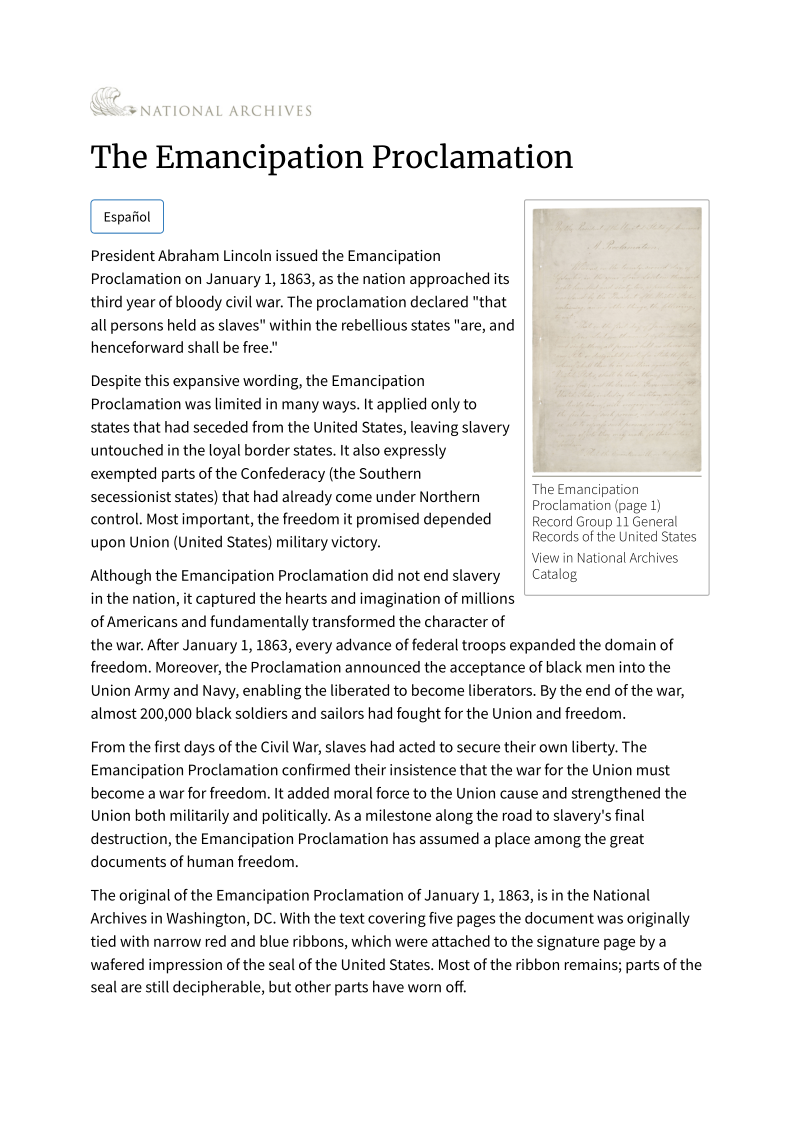Abraham Lincoln issued "The Emancipation Proclamation" in September 1862 and it became effective on January 1, 1863.
- Type
- Website
- Source
- The National Archives and Records Administration Non-LDS
- Hearsay
- Direct
- Reference
"The Emancipation Proclamation," The National Archives and Records Administration, August 5, 2021, accessed December 16, 2021
- Scribe/Publisher
- The National Archives and Records Administration
- Audience
- Internet Public
- Transcription
President Abraham Lincoln issued the Emancipation Proclamation on January 1, 1863, as the nation approached its third year of bloody civil war. The proclamation declared "that all persons held as slaves" within the rebellious states "are, and henceforward shall be free."
Despite this expansive wording, the Emancipation Proclamation was limited in many ways. It applied only to states that had seceded from the United States, leaving slavery untouched in the loyal border states. It also expressly exempted parts of the Confederacy (the Southern secessionist states) that had already come under Northern control. Most important, the freedom it promised depended upon Union (United States) military victory.
Although the Emancipation Proclamation did not end slavery in the nation, it captured the hearts and imagination of millions of Americans and fundamentally transformed the character of the war. After January 1, 1863, every advance of federal troops expanded the domain of freedom. Moreover, the Proclamation announced the acceptance of black men into the Union Army and Navy, enabling the liberated to become liberators. By the end of the war, almost 200,000 black soldiers and sailors had fought for the Union and freedom.
From the first days of the Civil War, slaves had acted to secure their own liberty. The Emancipation Proclamation confirmed their insistence that the war for the Union must become a war for freedom. It added moral force to the Union cause and strengthened the Union both militarily and politically. As a milestone along the road to slavery's final destruction, the Emancipation Proclamation has assumed a place among the great documents of human freedom.
The original of the Emancipation Proclamation of January 1, 1863, is in the National Archives in Washington, DC. With the text covering five pages the document was originally tied with narrow red and blue ribbons, which were attached to the signature page by a wafered impression of the seal of the United States. Most of the ribbon remains; parts of the seal are still decipherable, but other parts have worn off.
The document was bound with other proclamations in a large volume preserved for many years by the Department of State. When it was prepared for binding, it was reinforced with strips along the center folds and then mounted on a still larger sheet of heavy paper. Written in red ink on the upper right-hand corner of this large sheet is the number of the Proclamation, 95, given to it by the Department of State long after it was signed. With other records, the volume containing the Emancipation Proclamation was transferred in 1936 from the Department of State to the National Archives of the United States.
- BHR Staff Commentary
As Don L. Penrod notes in "Edwin Rushton as the Source of the White Horse Prophecy," BYU Studies 49, no. 3 (2010):, 81:
Within the text of the original document are found clues that may help us ascertain the date of its writing. One clue is found in the wording “they will be afraid of becoming Slaves again.” The document speaks of a terrible revolution taking place in America, with England being neutral till the condition becomes “so inhuman to look at and to Stop the Shedding of Blood, France & England will be Allied together and come with the intention to make Peace” and the black horse “will Flee to the invaders and Join in with them for they will be afraid of becoming Slaves again” (fig. 8). Presumably this is a reference to the enslavement of blacks in the United States. There is nothing in the document prophesying the freeing of the slaves, which would have to occur before they would fear becoming slaves “again.” The Emancipation Proclamation, issued in September 1862, became effective on January 1, 1863. Mentioning this fear of re-enslavement indicates that Rushton wrote the document after the end of the Civil War.
- Citations in Mormonr Qnas
The B. H. Roberts Foundation is not owned by, operated by, or affiliated with the Church of Jesus Christ of Latter-day Saints.

